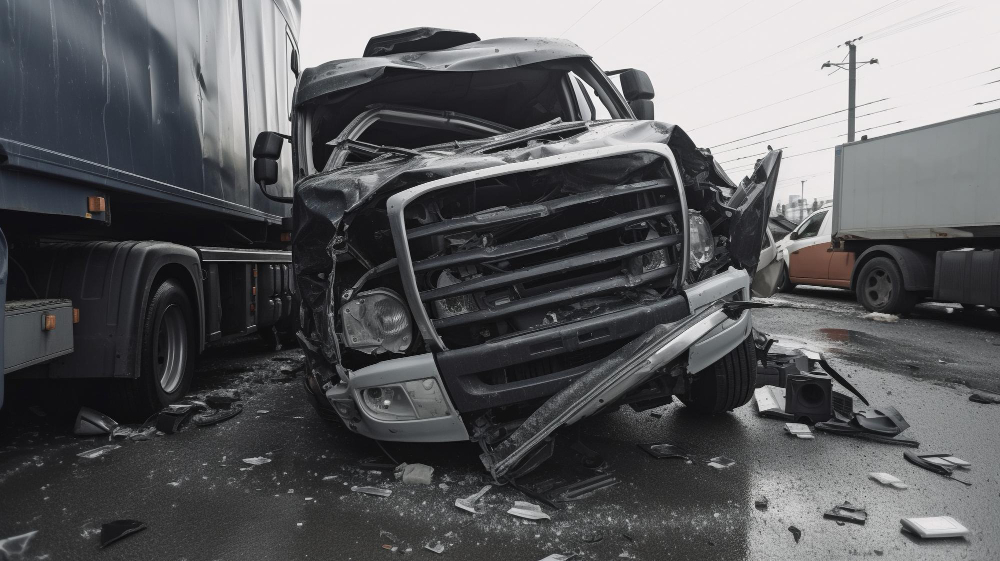How Does the Size and Weight of a Truck Impact a Truck Accident Case?
- 1 Truck Size and Weight – Key Measurements and Attributes
- 2 How Truck Size and Weight Negatively Impact Crashes
- 2.1 1. Greater Force of Impact
- 2.2 2. Slower Stopping Time
- 2.3 3. Increased Rollover Propensity
- 2.4 4. Enhanced Underride Risk
- 2.5 5. Expansive Blind Spot Zones
- 3 How An Attorney Investigates Truck Size and Weight Factors
- 3.1 1. Inspecting the Truck and Trailer
- 3.2 2. Obtaining Vehicle Weight Records
- 3.3 3. Gathering Cargo Documentation
- 3.4 4. Retrieving Telematics Driving Data
- 3.5 5. Consulting Recognized Subject Matter Experts
- 4 Why a Lawyer Is Essential After a Truck Accident
- 5 FAQs:
- 5.1 What makes commercial trucks so much larger and heavier than standard vehicles?
- 5.2 How do the size and weight of trucks affect collision severity?
- 5.3 What steps can an attorney take to investigate the truck size and weight factors after an accident?
- 5.4 Why is legal representation essential after a truck accident?
- 5.5 How can truck size and weight contribute to accidents involving smaller vehicles?
- 5.6 What are some common injuries resulting from accidents involving commercial trucks?
- 5.7 Are there regulations in place to address the size and weight of commercial trucks?
- 5.8 What should I do if I’ve been involved in a truck accident?
- 5.9 Can I pursue compensation for my injuries if I was partially at fault in the accident?
- 5.10 How long do I have to file a lawsuit after a truck accident?
- Truck Size & Weight: Commercial trucks are significantly larger and heavier than standard vehicles, with tractor-trailers weighing up to 80,000 lbs when fully loaded.
- Impact on Crashes: The immense size and weight of trucks result in greater force of impact, longer stopping distances, increased rollover risk, higher chance of underride accidents, and larger blind spots, all contributing to more severe injuries in collisions.
- Legal Assistance: An experienced personal injury attorney can thoroughly investigate the truck size and weight factors, gather crucial evidence, and navigate the complexities of commercial truck litigation to secure maximum compensation for victims.
Suppose you or a loved one have been seriously harmed in an accident involving a large commercial truck like a semi-trailer or big rig. In that case, you must understand precisely how the sheer physical size and immense weight of these vessels impact accident cases.
Here, you will learn:
- The key measurements and attributes that give trucks their extreme mass and dimensions
- How specific elements of a truck’s size and weight negatively affect collision trauma and injury severity
- What proactive steps an experienced personal injury attorney can take to thoroughly investigate the truck size and weight factors and incorporate them into building a compelling injury claim
Gaining deeper insight into these details will equip you to make well-informed decisions about your legal options after suffering an accident with a commercial vehicle.
Truck Size and Weight – Key Measurements and Attributes

To fully grasp how commercial semi trucks differ from standard passenger vehicles, it is helpful first to understand exactly how massive these road vessels truly are in terms of both scale and weight capacity.
Commercial tractor-trailers are essentially two components – the tractor unit which houses the driver, and the attached cargo trailer unit. Here are the typical specifications:
Tractor Unit:
- Length – Avg 10 to 15 feet
- Width – 8.5 to 9 feet
- Weight – around 15,000 to 25,000 lbs
Cargo Trailer:
- Length – Avg 28 to 53 feet
- Width – 8.5 to 9 ft
- Empty Weight – 7,000 to 15,000 lbs
- Max Payload Weight – Up to 65,000 lbs Total Combined Tractor + Loaded Trailer Weight – Up to 80,000 lbs
To put this into perspective, a fully loaded commercial semi-truck can weigh over 160 times more than a typical midsized sedan. It may be carrying the equivalent of 8 African elephants in cargo weight alone.
When connected, the average 53-foot tractor-trailer unit is longer than 4 combined Toyota Camrys parked end to end.
Other key attributes that give trucks greater risk include:
- Total Height – Up to 13 feet 6 inches tall
- High Center of Gravity – More prone to rollovers
- Large Blind Spots – Cannot directly see up to 28 feet behind the trailer
These enormous measurements directly translate into devastating truck accident statistics.
How Truck Size and Weight Negatively Impact Crashes
Due to significant discrepancies in physical size and weight capacities compared to standard automobiles, commercial trucks inflict far greater damage and injury in any collision scenario.
Here are 5 key ways a truck’s extreme mass and scales lead to heightened crash trauma:
1. Greater Force of Impact
By basic physics law, Force = Mass x Acceleration. So when an 80,000 lb semi-truck traveling at highway speeds rear-ends a 3,000 lb sedan, the equation spells danger. Due to drastically higher mass, the truck imparts much greater impact force into the car, crushing it more extensively. This causes amplified occupant injuries.
2. Slower Stopping Time
Greater mass also equals greater momentum for moving objects to physics principles. So trucks require much lengthier stopping distances than cars when braking at the same speeds. For example, at 65 mph, an average loaded tractor-trailer needs 525 feet to stop fully, which is over 2 times longer than a sedan. Their slower deceleration leads to more violent collisions.
3. Increased Rollover Propensity
The elevated ride height of commercial trucks raises their center of gravity significantly compared to lower-riding automobiles. This makes trucks much more prone to tipping over or rolling at high speeds or while maneuvering turns. Rollover events often cause occupant ejection, leading to severe or fatal crushing injuries.
4. Enhanced Underride Risk
Due to a truck’s high ground clearance, smaller vehicles can readily slide under them during collisions. This frequently causes passenger compartments to be disastrously crushed under the entire weight of the truck. Underride circumstances dramatically increase trauma severity.
5. Expansive Blind Spot Zones
Large trucks have significantly bigger blind spot zones around them due to much greater length and width dimensions. Estimates indicate truckers cannot directly see up to 28 feet immediately behind their 53-foot trailers – enough space to “hide” an entire school bus full of children! Blind spot mishaps often sideswipe unsuspecting motorists.
As demonstrated above, when all evidence is thoroughly documented, a truck’s enormous physical size and weight capacities directly magnify and enhance occupant injuries in crashes. An experienced injury law firm understands this and can build a compelling case.
How An Attorney Investigates Truck Size and Weight Factors

After suffering through an accident involving a massive commercial vehicle, contacting a personal injury firm that you can trust is critical for increasing the chances of a maximized financial recovery.
An accomplished semi-truck injury attorney has deep knowledge of these cases and will vigorously investigate all aspects related to truck size and weight using precise scientific methods. Proactive steps counsel can take include:
1. Inspecting the Truck and Trailer
The attorney will immediately dispatch their investigative team of trained accident reconstruction experts to fully examine, measure, and digitally scan the truck and trailer. This includes capturing exact width, height, length, and clearance dimensions, as well as cargo storage configurations. Photographing identifiable info numbers for tracing ownership history can also be useful. Documenting these specifications provides solid foundational evidence.
2. Obtaining Vehicle Weight Records
The lawyer will acquire authenticated copies of the truck’s most recent state weigh station tickets through formal request channels like subpoenas. This definitively proves the confirmed gross vehicle weight shortly before the accident occurred. Establishing precise weight data points further validates the case.
3. Gathering Cargo Documentation
In addition to vehicle weight, attorneys will also gather official records detailing specifics of the truck’s cargo contents, load distribution securing methods, as well as loading practices. For instance, confirmation that a truck exceeded maximum axle weight capacities can prove negligence. This is necessary for a victim to be awarded compensation for their injuries.
4. Retrieving Telematics Driving Data
Many modern trucks contain event data recorders akin to “black boxes” along with sophisticated telematics systems that capture intensive driving inputs. These may include speed, acceleration, braking force, stability assist activations, load balance, and more. Counsel will acquire granular pre-crash telematics driving data to potentially reveal critical negligent actions like speeding, which may have caused the wreck.
5. Consulting Recognized Subject Matter Experts
Specialized fields require input from credentialed subject matter experts. Experienced trucking attorneys maintain trusted working relationships with accredited accident reconstructionists, biomechanical engineers, vocational experts, and others. By consulting these veteran specialists to examine evidence and provide expert testimony, the lawyer builds an even more authoritative case.
As demonstrated above, the multi-disciplined legal team has comprehensive resources and knowledge to thoroughly investigate and document how a commercial truck’s immense physical size and weight factors directly contribute to enhancing occupant injuries in a crash.
Why a Lawyer Is Essential After a Truck Accident
Given the complexities of commercial truck litigation and tactics used by billion-dollar insurance conglomerates, attempting to handle your traffic injury case without a personal injury firm that you can trust is extremely unwise and hazardous.
Here are 5 key benefits retaining a proven legal advocate brings:
- Higher Financial Compensation: Per recent injury claim data, clients represented by specialized counsel receive over 3.5x larger settlement payouts on average than unrepresented individuals.
- Levels the Playing Field: Against trucking companies’ vast legal armies, lawyers evenly balance the scales to protect your best interests.
- Reduces Hassles Counsel lifts all admin burdens so you can focus energy on healing and family.
- Extensive Case Resources Law firms offer an unmatched breadth of expertise, tools, and capital for claim development.
- Results-driven attorneys are fueled by a bullish determination to relentlessly fight battles to win cases and earn maximum restitution for clients.
So, to greatly enhance the chances of an optimal legal outcome after any truck collision, aligning with an exceptional personal injury law firm is always advisable.
FAQs:
What makes commercial trucks so much larger and heavier than standard vehicles?
Commercial trucks consist of two main components – the tractor unit and the cargo trailer, which together can weigh up to 80,000 lbs when fully loaded with cargo.
How do the size and weight of trucks affect collision severity?
Trucks exert greater force of impact, require longer stopping distances, have an increased risk of rollovers and underride accidents, and possess larger blind spots, all leading to more severe injuries in crashes.
What steps can an attorney take to investigate the truck size and weight factors after an accident?
Attorneys can inspect the truck and trailer, obtain vehicle weight records, gather cargo documentation, retrieve telematics driving data, and consult recognized subject matter experts to build a compelling case.
Why is legal representation essential after a truck accident?
Specialized attorneys can level the playing field against trucking companies, handle administrative burdens, provide extensive case resources, and significantly increase the chances of obtaining higher financial compensation.
How can truck size and weight contribute to accidents involving smaller vehicles?
Trucks have larger blind spots, require more space to maneuver and stop, and can cause underride accidents where smaller vehicles slide underneath, leading to catastrophic injuries for occupants.
What are some common injuries resulting from accidents involving commercial trucks?
Common injuries include traumatic brain injuries, spinal cord injuries, fractures, internal injuries, and severe lacerations, often requiring extensive medical treatment and rehabilitation.
Are there regulations in place to address the size and weight of commercial trucks?
Yes, there are federal and state regulations governing the size, weight, and loading of commercial trucks to ensure safety on the road.
What should I do if I’ve been involved in a truck accident?
Seek medical attention immediately, report the accident to the authorities, gather evidence if possible, and consult with a personal injury attorney experienced in handling truck accident cases.
Can I pursue compensation for my injuries if I was partially at fault in the accident?
In some states, you may still be eligible to receive compensation for your injuries even if you were partially at fault, depending on the laws of comparative negligence.
How long do I have to file a lawsuit after a truck accident?
The statute of limitations for filing a personal injury lawsuit varies by state, but it’s crucial to act promptly and consult with an attorney to ensure you meet the applicable deadlines.

















